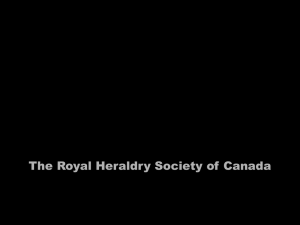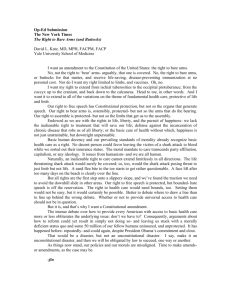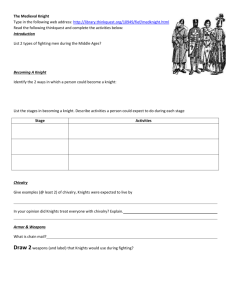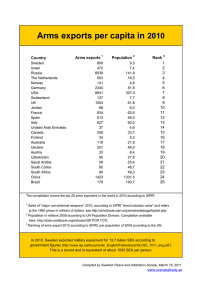South African Personal ("Family") Coats of Arms
advertisement
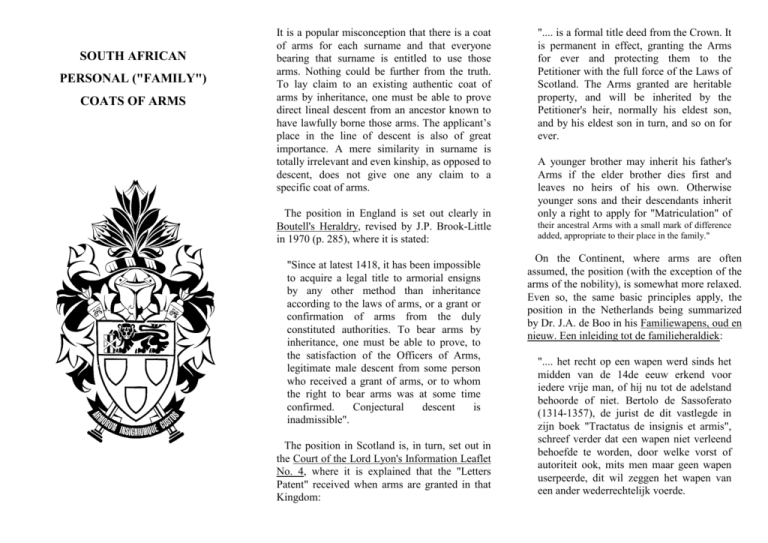
SOUTH AFRICAN PERSONAL ("FAMILY") COATS OF ARMS It is a popular misconception that there is a coat of arms for each surname and that everyone bearing that surname is entitled to use those arms. Nothing could be further from the truth. To lay claim to an existing authentic coat of arms by inheritance, one must be able to prove direct lineal descent from an ancestor known to have lawfully borne those arms. The applicant’s place in the line of descent is also of great importance. A mere similarity in surname is totally irrelevant and even kinship, as opposed to descent, does not give one any claim to a specific coat of arms. The position in England is set out clearly in Boutell's Heraldry, revised by J.P. Brook-Little in 1970 (p. 285), where it is stated: "Since at latest 1418, it has been impossible to acquire a legal title to armorial ensigns by any other method than inheritance according to the laws of arms, or a grant or confirmation of arms from the duly constituted authorities. To bear arms by inheritance, one must be able to prove, to the satisfaction of the Officers of Arms, legitimate male descent from some person who received a grant of arms, or to whom the right to bear arms was at some time confirmed. Conjectural descent is inadmissible". The position in Scotland is, in turn, set out in the Court of the Lord Lyon's Information Leaflet No. 4, where it is explained that the "Letters Patent" received when arms are granted in that Kingdom: ".... is a formal title deed from the Crown. It is permanent in effect, granting the Arms for ever and protecting them to the Petitioner with the full force of the Laws of Scotland. The Arms granted are heritable property, and will be inherited by the Petitioner's heir, normally his eldest son, and by his eldest son in turn, and so on for ever. A younger brother may inherit his father's Arms if the elder brother dies first and leaves no heirs of his own. Otherwise younger sons and their descendants inherit only a right to apply for "Matriculation" of their ancestral Arms with a small mark of difference added, appropriate to their place in the family." On the Continent, where arms are often assumed, the position (with the exception of the arms of the nobility), is somewhat more relaxed. Even so, the same basic principles apply, the position in the Netherlands being summarized by Dr. J.A. de Boo in his Familiewapens, oud en nieuw. Een inleiding tot de familieheraldiek: ".... het recht op een wapen werd sinds het midden van de 14de eeuw erkend voor iedere vrije man, of hij nu tot de adelstand behoorde of niet. Bertolo de Sassoferato (1314-1357), de jurist de dit vastlegde in zijn boek "Tractatus de insignis et armis", schreef verder dat een wapen niet verleend behoefde te worden, door welke vorst of autoriteit ook, mits men maar geen wapen userpeerde, dit wil zeggen het wapen van een ander wederrechtelijk voerde. Iedere Nederlander mag een wapen voeren en hij mag elk wapen voeren dat hij wenst, behoudens de door de Kroon verleende - en bij de Hoge Raad van Adel geregistreerde wapens van adellijke families en openbare lichamen. Het is bovendien een goede gewoonte om niet het wapen van iemand anders aan te nemen of te voeren. Overeenkomst in familienaam geeft nooit recht op een familiewapen, tenzij verwantschap is bewezen. Strikt genomen hebben alleen agnatische afstammelingen, de nakomelingen in mannelijke lijn, het recht om een wapen onverandered verder te voeren." In South Africa, as in the British Isles, Europe and elsewhere, nobody may usurp someone else's arms as their own. Those who cannot prove their claim to ancestral arms are free to apply for the registration of new arms in their name, if they so wish. Arms so registered are protected by the full force of the law. Application for registration of arms can be made in terms of the provision of section 7(1) of the Heraldry Act, 1962. Sections 7(5) and 7(6) of the Act further provides for the registration of arms for descendants (including adopted children). The public should thus be wary of offers to provide them with their "family coat of arms" inevitably reproduced from some popular heraldic article or publication, but without any proof whatsoever that the person to whom the offer is made is a direct descendant of any person who might have borne those arms, or indeed that they are even remotely related! In terms of section 23(a) of the Heraldry Act, it is an offence in South Africa for any person to furnish a "family coat of arms", unless the supplier has been able to satisfy the State Herald as to the authenticity of the arms in question and is in possession of a certificate to this effect, issued by the State Herald. This provision became necessary in order to protect gullible members of the public from the activities of unscrupulous arms hawkers who offer “family” coats of arms in computer-generated or other forms. Anyone requiring further information is welcome to contact the Bureau of Heraldry, Private Bag X236, Pretoria, 0001. (Tel. (012) 323-5300 or Fax (012) 323-5287). E-mail: arg13@dacst4.pwv.gov.za.

